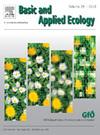Changes in weed vegetation across transects in maize fields
IF 3.5
2区 环境科学与生态学
Q2 ECOLOGY
引用次数: 0
Abstract
Weed vegetation in Central Europe has strongly changed during the last decades in response to changing agricultural practices. In addition, the cultivation of certain crops such as maize has expanded strongly. Fields are characterized by gradients from the edge to the interior, which may have ramifications on the weed vegetation. Here, we analyzed the composition of weed vegetation in maize fields from the edge to the interior documented by 101 transects consisting of three plots (10 m2) from Central Europe. In total, 203 species were recorded, including 107 (52 %) natives, 48 (24 %) archaeophytes, and 48 (24 %) neophytes. While the edge plots had a median species richness of nine species, the central plots (10 m from the field edge) and the interior plots (50 m from the field edge) both had a median of four species. Weed species cover declined more drastically from a median of 28.9 % total cover to 6.2 % to 5.0 %. Community indices (based on Ellenberg Indicator Values) changed along transects. Mean community index for light decreased towards the center, while the community index for moisture increased. The community index for nutrients increased from the edge to the central plot, but not to the interior plot. Species turnover was significant between the edge, central and interior plots. Species richness of the transects was influenced by landscape context and climate. Mean annual temperature, the amount of surrounding forests and maize fields were significant negative predictors of species richness, whereas surrounding water bodies, ruderal vegetation and built-up areas were significant positive predictors. Given that maize cultivation has rapidly expanded during the last decades, making it one of the most important crops in Central Europe, our study provides important insights into the composition of weed vegetation of a major, yet understudied component of modern agricultural landscapes.
玉米田样带杂草植被的变化
在过去的几十年里,中欧的杂草植被发生了巨大的变化,以应对不断变化的农业实践。此外,玉米等某些作物的种植面积也大幅扩大。田的特征是由边缘到内部的梯度,这可能对杂草植被产生影响。本文对中欧地区3个样地(10 m2)的101个样地进行了从边缘到内部的杂草植被组成分析。共记录到203种,其中原生植物107种(52%),古植物48种(24%),新植物48种(24%)。边缘样地的物种丰富度中值为9种,而中心样地(距离边缘10 m)和内部样地(距离边缘50 m)的物种丰富度中值均为4种。杂草覆盖的下降更为剧烈,从28.9%的中位数下降到6.2% ~ 5.0%。群落指数(基于Ellenberg指标值)沿样带变化。平均群落光指数向中心减小,水分指数向中心增大。养分群落指数从边缘向中心样地呈上升趋势,而向内部样地呈下降趋势。边缘、中心和内部样地间物种更替显著。样带物种丰富度受景观文脉和气候的影响。年平均气温、周围森林和玉米地面积是物种丰富度的显著负向预测因子,而周围水体、原始植被和建成区是物种丰富度的显著正向预测因子。鉴于玉米种植在过去几十年中迅速扩大,使其成为中欧最重要的作物之一,我们的研究为现代农业景观中一个主要但尚未得到充分研究的组成部分的杂草植被的组成提供了重要的见解。
本文章由计算机程序翻译,如有差异,请以英文原文为准。
求助全文
约1分钟内获得全文
求助全文
来源期刊

Basic and Applied Ecology
环境科学-生态学
CiteScore
6.90
自引率
5.30%
发文量
103
审稿时长
10.6 weeks
期刊介绍:
Basic and Applied Ecology provides a forum in which significant advances and ideas can be rapidly communicated to a wide audience. Basic and Applied Ecology publishes original contributions, perspectives and reviews from all areas of basic and applied ecology. Ecologists from all countries are invited to publish ecological research of international interest in its pages. There is no bias with regard to taxon or geographical area.
 求助内容:
求助内容: 应助结果提醒方式:
应助结果提醒方式:


